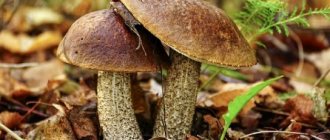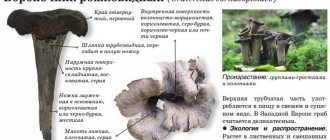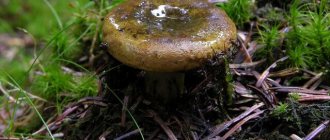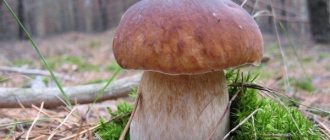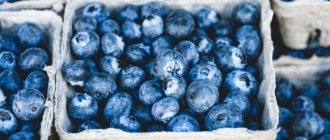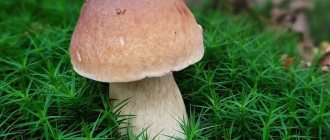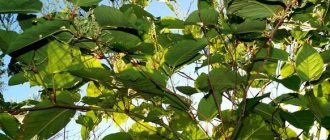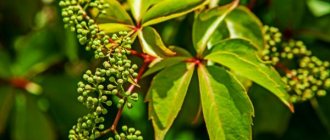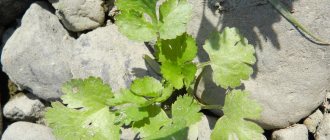» Mushrooms » Conditionally edible mushrooms » Skripun mushroom: external description and beneficial properties
0
1110
Article rating
The squeaky mushroom is widespread in Russian forests. It is considered conditionally edible, which means that it is suitable for consumption only in processed form, in particular, salted. It is also called milkweed, felt milkweed and violin.
- Beneficial features
- Place and time of growth
- How to properly process and cook
- Use in medicine
- Growing at home
Squeaky mushroom: external description and beneficial properties
Features and description
The mushroom has a pleasant mushroom taste and aroma. Below we will talk about how to recognize and understand that it is the creaking mushroom that is growing in front of your feet, because it is easy to confuse it with other similar mushrooms.
- Hat. Dense consistency, dry and fleshy, reaches 6 centimeters in diameter, but sometimes can reach 25 centimeters. The young mushroom has a convex cap, and a depressed one in the middle; the edges are turned inward. As it ages, it takes on a funnel-shaped appearance where the edges are cracked. A young mushroom has a milky cap color, but as it ages it turns yellow or acquires an ocher tint with yellow spots. The name of the mushroom was coined because of the felt surface, which squeaks when touched with a fingernail, knife, etc.
- The leg is not high, about 5 centimeters in height, the thickness is also about 5 centimeters. It is dense, straight, smooth, and tapers slightly under the cap.
- The pulp is fragile, hard, white, and easy to break with light pressure. It secretes a burning, milky white juice that turns yellow in air.
- The plates are sparse, hanging slightly on the stem of the mushroom. As soon as the mushroom begins to grow, the plates are white, but as they ripen they change to a yellowish tint.
Bitterweed or bitterweed, or bitterweed, or bitter milk mushroom
Bittersweet is a conditionally edible mushroom of the Russula family, genus Milky. This mushroom is also called bitter milk mushroom, red bitterweed, bitterweed and bitterweed.
Description of bitters
The diameter of the cap ranges from 4 to 10 centimeters. At first its shape is bell-shaped, then flat, and in mature mushrooms it becomes slightly depressed. A pointed cone-shaped tubercle remains in the center.
The edges of the cap are folded inwards and are thin in structure. The skin of the cap is red-brown, but becomes much lighter towards the edges. The surface is smooth with slight pubescence. In humid weather the cap becomes sticky and shiny.
The pulp is brittle, dense, has a barely perceptible odor, and has a peppery taste. When the pulp is damaged, a sharp, thick, white milky juice is released. When cut, the color of the pulp does not change.
The length of the leg reaches 4-7 centimeters. Its color is reddish, its shape is cylindrical. The leg is thin, matte, slightly thickened at the base. The surface of the leg is covered with whitish fluff. The lamellae descending along the stem, often located, wide. Spores are oval, reticulate. Spore powder is white.
Variability of bitter milk mushrooms
The color of the cap remains unchanged, but the stem is initially solid, but as it grows it becomes hollow, sometimes a spongy substance appears in it. The color of the leg is first grayish and then becomes reddish. The color of the plates varies from light brown to whitish. The flesh is white, and is often redder at the base.
Distribution and ecology of bitterling
Bitterweeds form mycorrhizae with conifers and birches. They can often be found in coniferous forests. They mainly grow in acidic soils. Bitter milk mushrooms are known in many regions; they are the most common species of the Milk genus.
The harvest season for bittersweet is summer-autumn. Since these mushrooms strongly accumulate radiocesium, they are not recommended to be collected in areas where Chernobyl fallout falls.
Nutritional qualities of horny weed
Bitter mushroom is a conditionally edible mushroom. These mushrooms are suitable for consumption in pickled and salted form. When salted they turn dark brown. To remove bitterness from bitters, it must be boiled and thoroughly soaked.
In foreign literature, these mushrooms are often classified as inedible, but in our country they are loved and collected. They are often classified as category 4 conditionally edible mushrooms. Mustards are most suitable for pickling, and they are rarely pickled.
Economic importance of bittersweet
A substance was found in the fruiting bodies of these mushrooms that prevents the growth of Staphylococcus aureus, Escherichia coli and other microorganisms. Due to the fact that an antibiotic substance is isolated from these mushrooms, they are actively used in medicine.
Similar species
- Camphor milkweed is an edible mushroom, but it is not in great demand among mushroom pickers because it has a specific taste;
- Liver milkweed is an inedible mushroom. The milky juice secreted by this fungus turns yellow when exposed to air;
- Swamp milkweed is similar in color to bittersweet, but it grows in swampy pine-spruce forests;
- Camphor mushroom is often confused with bitter mushroom. It is an edible mushroom that has the aroma of dried roots;
- The orange milk mushroom has a red-chestnut colored cap and the same stem.
Source:
When and where does the squeak grow?
The violin can be easily found from Western Europe to the Far East. As for forests, mushrooms can be found in:
- conifers;
- deciduous;
- mixed.
They are located where there is a lot of moss, old leaves and a lot of sunlight. In particular, the mushroom prefers to grow near aspen and birch trees. Basically, violin mushrooms grow in large groups, and a group can contain both young and old mushrooms. In rare cases, the mushroom can be found alone.
You can collect violins from mid-summer to late autumn; the most delicious and juicy mushrooms are those that ripen at the end of summer.
Mushroom picking
Each type of mushroom has characteristics regarding its place of growth, soil, light and humidity. The mushroom grows:
- in the forest of middle age. In the young they do not yet have time to appear, but in the old they are overgrown;
- the grass near the trees should be low, in high places the harvest is less common;
- collected after rain, in the morning when there is dew;
- In places where it grows, a characteristic mushroom smell is felt.
Deadlines for collecting milk mushrooms:
- black is harvested in mid-summer and early autumn;
- the blue one gathers throughout August;
- oak and aspen are harvested from the end of July until the beginning of autumn;
- yellow and pepper are harvested from July until the end of summer.
All terms are conditional. The climate and soil must be moist when harvesting.
Milk mushrooms Edible or not edible Poisonous or not poisonous Differences between mushrooms. White mushroom and squeaky Edible mushrooms White mushroom is a valuable mushroom!
What can a creaker be confused with?
Many mushroom pickers may mistakenly confuse them with toadstools and pass by, but in vain, because toadstools are tasty and healthy. Mushroom pickers may also confuse this mushroom with milk mushrooms. The difference is that the creak is harder than the white milk mushrooms. And there is no fringe on their hat. The squeaky hat is almost like plastic, which cannot be said about milk mushrooms.
The plates of the milk mushroom are lighter than those of the violin; in the milk mushroom, the flesh at the site of the break begins to noticeably darken; in the violin, this is absent. The advantage is that the squeaky bird has no poisonous or harmful counterparts.
False doubles
The violin definitely does not have any absolutely inedible or poisonous counterparts. But it has similarities with other representatives of the mushroom world, for example, with real, dry and pepper milk mushrooms. You can clearly see the difference between them in the photo; they differ in taste and some external characteristics:
| Violin | Real breast milk (white) | Loader white | Pepper milk mushroom | |
| hat | With a felt surface, it makes a squeaking sound when in contact with foreign bodies | Densely pubescent with fringed edges | With light felt covering | Has a smooth surface |
| milky juice | Bitter with a burning taste, light in color; when exposed to air, it acquires a slight yellowish tint, and when it dries it becomes red-brown. | White in color, bitter in taste, when cut it acquires a gray-yellow tint. | Doesn't have | Light in color, with a peppery taste; when the cap is broken, it changes color to olive green |
| Leg | Solid with a dense structure | In adult mushrooms it is hollow | In adult fruiting bodies, it acquires a brownish tint and becomes hollow. | Solid |
| Records | Rare, thick | Infrequent, wide | Frequent, thin | Frequent, narrow |
Reference! Both the white milk mushroom and the creaking milk mushroom secrete milky juice at the cut of the cap. But in real milk mushrooms, when exposed to air, it acquires a gray-yellow color, while in felt milk mushrooms, the shade of the juice practically does not change.
You can also confuse the squeaky one with the white one - the white wave. However, both mushrooms have signs by which they can be easily distinguished:
- the white milk mushroom has a rich white color, while the felt milk mushroom has a milky tint, which becomes darker with age;
- the white wave is smaller in size than the creaking one; the diameter of its cap can reach a maximum of 6 cm; the cap also differs in shape, since it has edges curved inward.
Proper processing
As soon as the mushrooms have been brought home from the forest, the first thing they should do is sort them out and free them from adhering leaves and other dirt. Next, the mushrooms are washed and soaked in salt water. After this, the creaks can be boiled, fried, stewed, made various sauces, dried or pickled, but all this after preliminary boiling.
Soaking lasts 5 days in cold, clean water. This must be done if you decide to pickle mushrooms or cook them in any other way. During this time, the water should be changed several times to clean water.
In addition to the fact that the mushroom contains many beneficial substances, it also contains harmful components that make the fresh mushroom bitter. It’s not even a matter of taste; if this mushroom is simply boiled or fried, then attacks of nausea and vomiting and gastrointestinal poisoning may occur, which is why it is so important to pre-soak and dry or pickle them.
Subtleties of salting squeaks for the winter
Squeaky milk mushrooms are classified as conditionally edible mushrooms. These forest products are preserved in pickled or salted form. Like other mushrooms that belong to the laticifers, creaks necessarily require pre-treatment.
First, you should thoroughly clean the surface of the mushroom cap from dirt - to do this, it is better to leave the product to soak overnight in a bowl of water. Afterwards you need to trim the leg under the cap. And only then put it on the fire and cook for at least 10 minutes.
Advice! It is better to soak the squeaks for several days, since this way the juice, which is harmful to humans, is washed out.
Preserving squeaks for the winter is notable for the fact that they can subsequently be used for many purposes: frying, stewing, adding to soups or salads. Therefore, salting is considered the optimal way to preserve forest products. Moreover, all cooking recipes will make this product safe for consumption.
The conservation procedure itself takes place in several stages:
- Preparatory work for processing the main ingredient. Skripuny should be sorted and separated from other varieties.
- Clear forest product. It is thoroughly washed to remove various contaminants, since it grows near stumps and mosses.
- Soak in cool water for several days. The fluid needs to be changed several times.
- Chop large milk mushrooms.
- Preservation by any available method: cold, hot or dry pickling.
Only by following the basic manufacturing technology can you prepare a dense, crispy and tasty squeaky snack for the winter.
The benefits and value of the violin
Every person wants to get the maximum benefit from food, but not all products are rich in this, which cannot be said about squeaky mushrooms.
After the mushrooms are properly processed, they lose their harm and saturate the body with vitamins, amino acids and microelements (magnesium, potassium and calcium, and others). Violin contains 49% carbohydrates and 47% proteins. Mushrooms can even be consumed while on a diet, since there are 22 kcal per 100 grams of product.
Mushroom composition:
- proteins;
- fats;
- carbohydrates;
- water.
Minerals:
- calcium;
- potassium;
- iron;
- magnesium;
- phosphorus;
- sodium;
- zinc;
- copper;
- selenium;
- manganese.
Vitamins:
- vitamin C;
- thiamine;
- riboflavin;
- a nicotinic acid;
- choline;
- vitamin B6;
- betaine;
- vitamin B12;
- vitamin B;
- vitamin E;
- fatty acid.
Regular consumption of properly prepared mushrooms will have a positive effect on the functioning of the gastrointestinal tract, releasing bad cholesterol, lowering blood sugar and improving the functioning of the cardiac system.
Cooking recipes
Skripitsa is classified as a conditionally edible mushroom, which is assigned the fourth category of edibility. When properly processed, it is safe for the body, therefore it is successfully used in cooking. Skripun can be prepared for future use, pickled, and salted.
Primary processing and soaking
Before proceeding directly to the cooking process, it is necessary to carry out primary processing of the fruiting bodies to remove the milky juice from them.
Algorithm of actions:
- Sort through the mushrooms.
- Remove stuck leaves, moss and dirt particles.
- Rinse thoroughly with running water.
Then you can move on to the soaking process, which will help get rid of the bitter taste, toxins and harmful elements. Soaking should be done using two methods:
- Immersion in cold water. It is necessary to place the mushrooms in a salted liquid, in which they should remain for 5-7 days, and periodically change it to fresh liquid.
- Pouring boiling water. This method is considered faster; after only 3 days, the mushrooms are ready for further processing. In this case, the water will have to be changed quite often - up to 5 times a day.
Is it possible to fry and cook fiddle mushroom?
The violin is suitable for eating only in salted form. When boiling or frying, the bitterness in the fruit body remains, and when eating violin prepared in this way, there is a risk of adverse consequences.
Reference! Felt breast milk cannot be considered dangerous, because its composition does not contain any toxic substances that affect internal organs. But an attack of vomiting is possible if it is consumed fresh, boiled or fried.
Pickling
Salted violin is much inferior in taste to white milk mushrooms. But if you find the right recipe, you can get an excellent snack with a pleasant aroma. For preparations for the winter, fruits with a large and fleshy cap are suitable. It is recommended to select whole and fresh fruit bodies without signs of worms.
Hot
Ingredients:
- pre-soaked violin – 1 kg;
- table salt – 30 g;
- fresh currant leaves - several pieces;
- filtered water;
- allspice - a few peas;
- cloves – 2-3 pcs.;
- bay leaf – 1 pc.
Recipe:
- Pour water into an enamel pan, add salt.
- Place mushrooms in it, blanch them for 20-30 minutes, constantly skimming off the foam.
- Drain in a colander.
- Wait until it cools down.
- Place currant leaves on the bottom of the jar, add spices, add bay leaf.
- Place the creaks on top, caps down, while sprinkling each layer with table salt.
- Cover with currant leaves on top, close with a lid and put in the refrigerator for 1.5 months.
Reference! Currant leaves prevent the formation of mold. They can be replaced with cherry ones.
Cold
Salting for the winter can be cold.
The following ingredients will be required:
- felt milk mushroom - 1 kg;
- table salt - 50 g;
- bay leaf, cloves, peppercorns, garlic cloves - to taste;
- currant or cherry leaves - several pieces.
How to pickle a violin:
- Place the mushrooms in a wooden container in dense layers, caps down, sprinkling each with salt and spices.
- Cover with a ceramic plate on top and place a weight.
- Wait until the liquid is released. It should cover the mushrooms completely, and if this does not happen, then you should add a salt solution on top, prepared at the rate of 20 g of salt per 1 liter of water.
- Place the prepared creak into sterilized jars, caps down.
- Cover the top of the pickle with currant leaves.
- Close with lids.
- Place in the refrigerator for 1.5 months.
Crispy marinated squeaks using the hot method
Felted milk mushrooms can also be pickled and rolled into jars. This process is more labor-intensive because the mushrooms need careful preparation. But, according to reviews, the pickled squeaky cheese turns out crispy and aromatic.
Ingredients:
- violin – 1 kg;
- water - 1 tbsp.;
- table salt - 40 g;
- onion - 1 pc.;
- cherry leaves - several pieces;
- horseradish leaf – 1 pc.;
- dill umbrella – 1 pc.;
- black peppercorns - to taste.
Step-by-step marinating recipe:
- Peel and rinse the mushrooms in cold water at least three times.
- Fill with water overnight.
- In the morning, drain the water and rinse each mushroom again under running water.
- Place in an enamel container, add water and bring to a boil, periodically skimming off any foam that appears.
- Drain in a colander or sieve.
- Rinse again and soak in cold water for half an hour.
- Drain the liquid and rinse the mushrooms several times.
- Prepare sterilized jars.
- Place spices on the bottom, a layer of mushrooms on top, chopped onion rings and a horseradish leaf on top.
- Boil water for the marinade with salt and pepper.
- Pour brine over the mushrooms, sterilize the jars for 30 minutes, and roll up.
Contraindications
Even people in good health should not eat a lot of mushrooms often, since this product is considered difficult for the stomach. They also contain a large amount of protein, which is also a big burden on the digestive system.
People with the following disorders should forget about mushrooms:
- exacerbation of diseases of the digestive system;
- kidney and liver diseases;
- gout;
- individual intolerance;
- children under 12 years of age;
- pregnancy and lactation period.
Use
The nutritional value of violin is very questionable. Its milky juice is quite difficult to remove from the mushroom; this requires soaking for five days, changing the water twice a day. To speed up the process, mushrooms can be poured with boiling water, also changing the water regularly, but with this method of preparation, the mushroom loses some of its already poor taste.
After this, the mushroom is suitable for pickling, most often in a dry way, under pressure. But even in its salted form, violin is not anything special, and most often violin is collected in regions poor in mushrooms or in years of low yields of other types of commercial mushrooms.
Growing at home
The principle of growing violin is not complicated; you just need to purchase ready-made mycelium in the store. This option is more reliable and simpler, but, unfortunately, it is not sold everywhere.
Once the mycelium has been acquired, it is mixed with a preliminary substrate (a mixture of soil and hardwood sawdust). Next, you should collect leaves and moss in the forest, where many squeaky birds grow. Sowing should begin from May to September.
Next, a nutrient solution is made based on yeast and sugar, and the mycelium should be grown on soil closer to forest soil.
Some mushroom pickers plant as follows: overripe mushrooms are broken into pieces and mixed with peat and sawdust and watered with a nutrient solution. The container is covered with a lid, where small holes are made, and set aside for three days at a temperature of 23 degrees.
Before planting, the soil is watered with a lime solution, which should be diluted from 50 grams of lime per 10 liters of water. The holes are made closer to the deciduous wood, the prepared substrate is poured into the hole, filling it halfway. The mycelium is laid out on top and the prepared substrate is added to the top. At the end, moss and leaves are laid out.
You can also grow creaks in a basement or barn. To do this, you should fill a plastic bag with squeaky mushroom mycelium and make holes in it, from where the mushrooms will grow. In this case, they can be collected for 5 years in a row.
Although squeaky mushrooms are not one of the most delicious mushrooms, they can still be eaten. It is quite possible to be confused with some types of milk mushrooms, so you need to know how to distinguish a squeaky mushroom from another mushroom. It is also necessary to properly prepare the squeaks so that there are no problems with the digestive system.
0
0
Copy link
How to properly process and cook
The mushroom must be soaked before cooking.
Skripitsa is considered a conditionally edible mushroom, so for consumption it is cold-pickled.
But first, in order to remove bitterness and toxins, the crop needs to be soaked. Mushroom pickers talk about 2 options for soaking:
- Cold. Pour water over the mushrooms, add salt and leave for 5-7 days. The water must be renewed periodically (2-3 times a day). Then the mushrooms are boiled, and only then can they be salted.
- Hot (boiling water). Pour boiling water over the mushrooms. The water needs to be changed every 5 hours. The total soaking time is 3 days.
Felt milk mushrooms (violin) are best suited for pickling. But when boiled or fried, bitterness remains in it and there may be negative consequences for your health from consuming it in this form.
Recipe for making violin by cold pickling:
- Place bay leaf and black pepper (peas) on the bottom of the container (pan or other container). If desired, you can also add currant or cherry leaves.
- Place the mushrooms in the next layer, caps down, and sprinkle with coarse salt. You will need 50 g per 1 kg.
- The container is filled completely, layers of spices and mushrooms alternate. Afterwards, gauze folded in several layers is placed on the workpiece and a wooden circle (plate) is placed on it and something heavier is placed on it, pressed down and left for 2 weeks.
- After 14 days you can roll it up.
Cold salting is most common in various regions of Russia and each of them has its own little secrets. Very often, mushroom pickers recommend using oak leaves instead of bay leaves and cherry or currant leaves to give the pickling a “forest” spirit.
():
Pickling the violin is only half the battle. It is important that the result is what is called “to be devoured.” Therefore, it is important to know how to check whether everything was done correctly and, if possible, correct mistakes:
- After a week, take out a few mushrooms, smell and taste them. If the salting went well, the smell will be pleasant, sour, and the taste will be moderately salty.
- If there is a lack of salt: add it in the form of a solution of 1.5-2 tbsp/l of water.
- If there is not enough water, add so that it protrudes 1-2 cm above the fruiting bodies.
By the way. A musty smell is evidence of under-salting or a violation of the temperature regime during salting.
Of course, creaks are not milk mushrooms or white ones, but if they are prepared correctly, they can decorate your table in the fall and winter.
